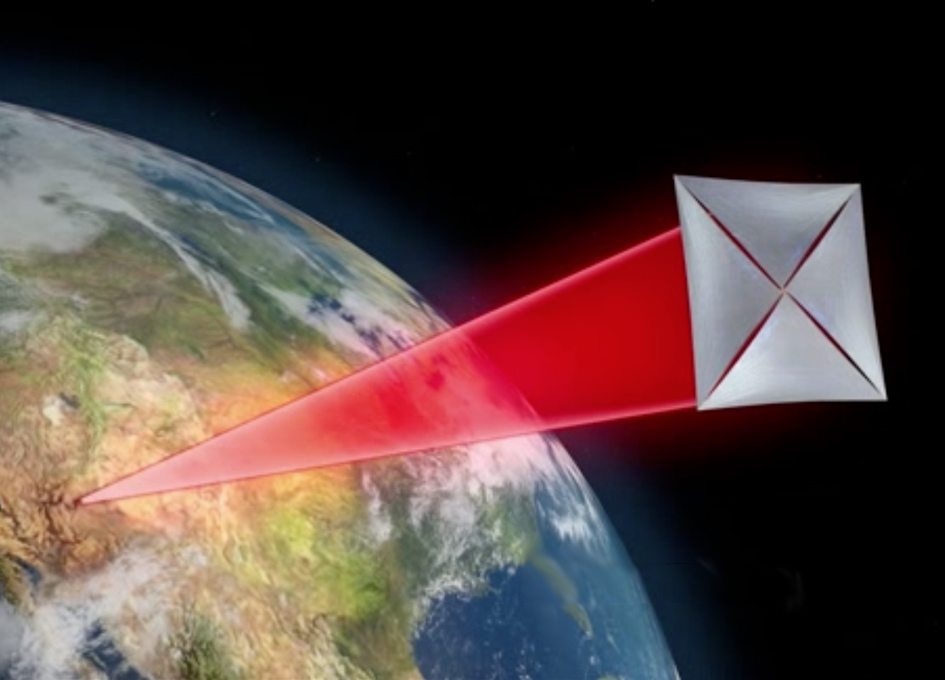
I learned this today. The energy from the photons in a laser beam can be used to propel a very light sail into space. A laser powered solar sail could let us look at the planets around the closest star to us.
Laser propulsion has been suggested as the best way we have of reaching the next star closest to our own. This is Proxima Centauri, and it is 40,208,000,000,000 km away from us. The speed of current spaceships is limited by the amount of power and fuel they can hold. To get a spaceship into space requires a huge amount of power to overcome Earth’s gravity. Building a spaceship in space and launching it would allow it to carry more fuel, but it still wouldn’t go very fast. Currently, the fastest man made object in space is the Voyager 1 space probe. It was launched in 1977 and has reached the speed of 61,500 km/h. To reach Proxima Centauri would take it about 74,633 years. That is a little longer than any of us can wait. Which is why laser propulsion has been suggested.
How does laser propulsion work? A laser is fired at the object, and a reflective surface on the object is used to reflect the laser back. When the light photons in the laser beam hit the mirror, they reflect back and as they do, they impart energy to the object, pushing it forwards. This laser can be fired from Earth, but it is probably easier if it is based in space as it wouldn’t have to go through our atmosphere. A laser with 100 gigawatts of power could accelerate a space probe of a few grams up to 20% of the speed of light in about ten minutes.
There is a current project called Breakthrough Starshot that is attempting to build such a space probe. Their idea is to create 1000 space probes that are a few grams each. They would have a camera, a communication system, and a sail that is 4 m by 4 m. The probes would be released in high-altitude Earth orbit and an array of lasers would be focused on them. The probes would be accelerated to 20% the speed of light and they would head towards Proxima Centauri. Many of them would be lost along the way, but some might just make it. At 20% the speed of light, they would make it there in about 25 years and the images they took would take another four years to get back to us.
There are several problems that need to be overcome. The sail has to be extremely strong and light. Graphene is a likely candidate, but it is not technically possible to build one yet. The amount of power that the laser would need is also difficult to produce. 100 gigawatts of power is the same as all the power that the city of New York uses over 100 days.
If it ever becomes possible to send a laser powered solar sail to other star systems in the Milky Way, there is so much that we could learn. We know that Proxima Centauri is a red dwarf star that only has 12.5% the mass of the sun, but it does have planets orbiting it. There are three altogether: Proxima Centauri b, Proxima Centauri c, and Proxima Centauri d. Proxima Centauri d is only one-quarter the size of Earth and it orbits its sun much too closely to have life. Proxima Centauri c is seven times the size of Earth, but its orbit is far too big for it to have life. It has an average temperature of -234℃. Proxima Centauri b, however, orbits within the goldilocks zone. It is most likely tidally locked to the star, which means that one side is always facing the star and one side facing away, just like our moon. This means that the probability of their being life there is slim, but not impossible. The planet may have an atmosphere and the advantage of a red star is that they burn for far longer than our sun does, which would give life a lot longer to evolve. There is no real way we can detect life from here, so a laser power space probe would be the perfect way to go and have a look.
Today, the technological challenges might be too difficult, but technology is evolving at a faster and faster rate. One day, it will probably be possible. There is an idea to put a large number of solar panels on Mercury that would be used to power the laser. Who knows what we will be able to do in the next few years?
So, a laser powered solar sail would work because a laser fired at it would impart energy when it was reflected off the probe’s sail. And this is what I learned today.
Photo by https://breakthroughinitiatives.org/
Sources:
https://en.wikipedia.org/wiki/Laser_propulsion
https://en.wikipedia.org/wiki/Breakthrough_Starshot
https://en.wikipedia.org/wiki/Beam-powered_propulsion
http://gareebscientist.com/isro-developing-laser-propulsion/
https://www.theverge.com/2016/4/16/11437598/alpha-centauri-starshot-project-stephen-hawking
https://www.businessinsider.com/breakthrough-starshot-laser-beam-power-2018-12
https://en.wikipedia.org/wiki/Proxima_Centauri
https://www.sciencefocus.com/space/how-fast-are-the-voyager-spacecrafts-travelling/
